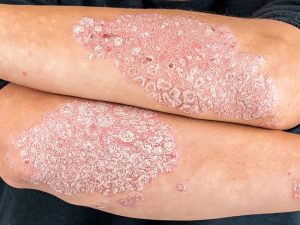The ABCDEs of Melanoma
Someone in America dies of melanoma, the most virulent form of skin cancer, every hour of every day of the year, and the incidence of melanoma has doubled since the 1980s, according to the National Cancer Institute. That’s the bad news.
The good news is that 92 percent of people who are diagnosed with melanoma survive more than five years, largely because the disease is visible and treatable before it spreads.
Jody Isbell, PA-C, at Associated Dermatology and Skin Care Clinic of Helena, knows the importance of prevention and early detection. She says anyone who has experienced multiple blistering sunburns in their teens has nearly double the risk for the disease.
Montana and surrounding states suffer melanoma at a higher rate than the rest of the country because residents underestimate the negative effect of the sun’s rays during the winter. Isbell recommends use of at least 30 SPF sunscreen on exposed skin year-round, not just during the summer.
The next most important protection is an annual head-to-toe skin check at your dermatologist’s office. “Check your birthday suit on your birthday,” Isbell says. For those with higher risk, such as anyone who has been diagnosed with skin cancer or precancer, every 3-6 months is recommended. If you’ve had one or more blistering sunburns in your past, or if you have a first degree relative with a melanoma diagnosis, then yearly skin checks are recommended.
Because exposure anywhere on your body can lead to melanoma anywhere else, it’s important to check every nook and cranny – between your fingers and toes, on your scalp, under your arms and on the bottom of your feet.
In the meantime, keep the ABCDEs of melanoma in mind:
A – Asymmetry: Normal moles and freckles are completely symmetrical, so if you see spots that don’t look the same on both sides, that’s a red flag.
B – Border: Benign moles and freckles have smooth edges. If you see a mole or spot with a blurry or jagged border, get it checked.
C – Color: Normal moles and freckles are uniform in color, but a cancerous cell may vary in shade. If you have a spot that is any combination of brown, tan, black or red, see a doctor.
D – Diameter: Ordinary moles are generally small. Spots that are larger than a pencil eraser are suspicious. Not all melanomas are large but it’s better to be safe and have it looked at by a medical professional.
E –Evolving: This is the most important: any changes over time to a mole or spot warrant a visit to the dermatologist.
Isbell points out that another E – elevated – is worth noting as well. Normal moles and freckles are smooth to the touch. Anything raised deserves a checkup.
“You could say E, F, G for elevated, firm, and growing because some melanomas don’t have color and spots that have these qualities but no color should also be looked at,” Isbell says
.
Skin cancer is almost always manageable when it is caught early.
For more information about keeping your skin safe, contact Associated Dermatology and Skin Care of Helena for an appointment at 406-324-7447 or laserclinic@associateddermhelena.com.







